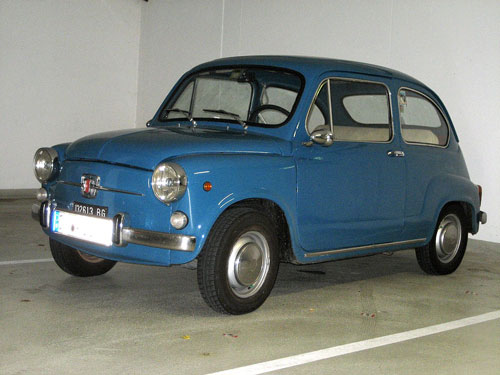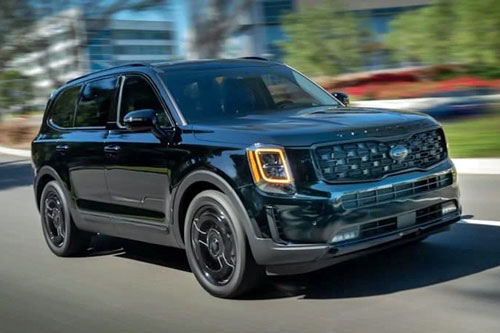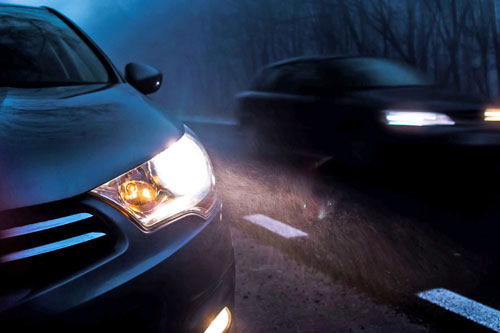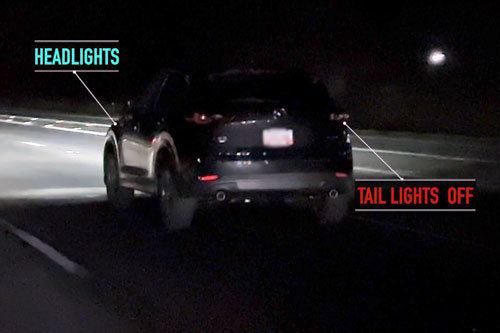Everybody knows the safest way to drive is with your headlights on. I used to do that back around the dawn of time in my first car, a tiny little Fiat 600. It’s equally tiny battery – from Magneti Marelli, Italy’s answer to England’s Lord Lucas, Prince of Darkness – had a real struggle keeping up.

But safety first, yes?
Canada was one of the first countries to make headlights-on mandatory, at the start of 1990.
Good on us.
The preferred term was Daytime Running Lights, a.k.a., DRL.
There were concerns that this would burn the headlights out prematurely. Thus, the approach taken by most manufacturers was to run DRL through the less-often-used high beams at reduced intensity, instead of normal low beams. Of course, the burn-out issue became moot with the adoption of modern long-life bulbs, such as halogens, HIDs, and LEDs.
The eventual downside of the high-beam approach has been that with the near-universal adoption of taller trucks and SUVs, following vehicles’ DRLs now shine right into your rearview mirror.
Of course, the government got the DRL regulation wrong.

For starters, vehicle manufacturing standards are federal, yet vehicle operating standards are provincial (or “state”, south of the border). So, your vehicle has to have DRL when you buy it new, but there is nothing to prevent you from disabling the DRL afterwards. Don’t know why you would want to, but former Car and Driver editor Csaba Csere used to advocate just that.
Second, if the DRL system does fail, as the early-production ones often did, there is no requirement for vehicle owners to have them repaired. Besides, unless you were a more vigilant driver than most of us are, you would never know they weren’t working. Who ever looks at their headlights in the daytime?
But the biggest flaw in the DRL law was that it only required that the front lights be on, not the rears.
In fact, when DRL was proposed for the United States, it turned out that some states actually had laws that if the front lights were on, then the rear lights also had to be on.
Why? Apparently, because bootleggers would modify their cars to not have the rear lights on, to make it more difficult for revenuers to follow them as they tried to escape at night with their illegal hooch.
Now, the entire point of DRL was to make your vehicle more visible to on-coming traffic, hence reduce head-on crashes, by far the most dangerous type. Good idea, although these crashes are obviously only an issue on roads with two-way traffic.

I don’t know what percentage of our traffic now runs on controlled-access freeways. But especially in urban areas, I’ll bet it is really high.
And front-only DRL is virtually pointless on such roads. If somebody is coming towards you on your side of a freeway, DRL is the least of your worries.
So, why doesn’t DRL legislation require ALL lights to be on, front and rear? Like the southern US already did?
Excellent question.
In the early days of DRL, most dashboards had indirect incandescent illumination, which only came on when you manually switched on the headlights. When it got dark, you knew to turn on your headlights because you couldn’t read the dash. My trusty (rusty…) 2003 VW Jetta TDI Diesel wagon is a perfect example.
But with the advent of the now-universal digital dashboards, this built-in warning went away. I know all of you have seen people driving along the road at night, blissfully unaware that they are invisible from behind. I wonder how many collisions have been directly caused by this “safety” device? These drivers can see their dash. They can see ahead of them. All’s good.
Not.
How can you warn such drivers that their lights aren’t on? You can’t flick your own lights off and on in their rearview mirror because the difference between your reduced-intensity high beam DRL and your regular headlights isn’t big enough for them to notice.
Or they just think you’re being a jerk.
I have pulled in front of such people and turned my lights off and on, or tapped my brake pedal, to try and warn them. They don’t get the message.

Many years ago, I even had one guy think maybe I was cop or something when I did this, and he pulled off onto the shoulder. I stopped behind him, reached into his car, and turned his lights on. He didn’t have a clue. I wouldn’t dare risk that today; he might have a Glock G17 under his seat.
So, why is there even a headlight switch in a vehicle? Ignition on, all lights on; ignition off, all lights off. Dead easy.
It’s what motorcycles have done for years, and how often do we get safety ideas from motorcycles?
Nope. It’s simple. No more headlight switches; everybody’s safer.
Do you know how much a headlight switch costs?
Neither do I. Maybe $10? Maybe $50? Depends on the vehicle, I guess. For the sake of argument, let’s go in low and say $5.
With some 80 million cars built every year world-wide, I just saved the car industry at least $400,000,000.
You’re welcome. I think a 5% commission would be appropriate.



